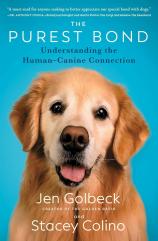The Purest Bond: Understanding the Human–Canine Connection
Review
The Purest Bond: Understanding the Human–Canine Connection
There's a new dog book in town, and it's written by two women who really know their dogs. In their nonfiction love story to dogs everywhere, THE PUREST BOND, the authors share all the reasons to bring a dog (or two or more) into your family.
Jen Golbeck rescues golden retrievers with special needs, including hospice care. She started what is an extremely popular Instagram page, The Golden Ratio. Stacey Colino is a science writer who has three rescue dogs. In this comprehensive and meticulously researched book, they explain the whys and hows of bringing a dog into your family. And while much of the material they share is not going to be novel information for those who are involved in rescue or the dog world, reading it reminded me of some things I knew but had put on a back burner.
"THE PUREST BOND is the kind of book that would make a great gift for someone who is thinking about getting their first dog, or even someone who has a dog but may not have read too much about them."
There are four parts to the book, each of which is comprehensive and includes scientific studies, as well as anecdotal stories to make points about how wonderful dogs are and how much they can improve our lives. The first part, “Creating Connection,” is about the bonds we form with dogs and how just having a dog can help us make human connections as well. Part Two is about how dogs enhance our health, which multiple studies have shown is true. Dogs not only encourage us to walk and move more, they actually can detect disease and assist us as service dogs. They also help with depression and anxiety, and there is much to be said for how a dog can lower blood pressure and make us feel safe.
Part Three was of special interest to me as it's about how dogs support us emotionally. Golbeck and Colino discuss the benefits of having dogs in schools and interacting with children. I know this is true because I brought a dog to school with me daily for almost a decade. Peanut, a facility dog, worked with me and helped my students feel comfortable and loved. She sat in difficult interviews with child protective services and helped the children being questioned feel secure. She also assisted the teachers, and whenever anyone at school saw her, even from a distance, they smiled. Before Peanut, two other dogs attended school with me: Bentley, a rescued herding dog, and Sadie, a Great Pyrenees whom I fostered when she was found at eight years old in Chicago. Both were certified therapy dogs who brought immeasurable joy to the students around them.
Part Four is the most difficult section to read, especially for those of us who have lost dogs. And those of us who are dog lovers, and dog rescuers, lose too many friends. The book really shares the dilemma that we face when wondering if the time is right to end the physical suffering of our beloved companions. I've lost three of my four dogs over the past four years, and there was definitely a lump in my throat as I read these pages.
I truly believe the study that shows that while breeds are great indicators of physical traits, breed alone does not reliably indicate personality. Those wanting a dog should research physical needs, like energy levels and grooming requirements, but then judge each dog individually. The only dog who ever bit me was, ironically, a golden retriever, yet my children grew up with extremely gentle Doberman pinschers. On the other hand, I fostered an amazing 10-year-old golden who was adopted into a wonderful home and lived five years there, getting all the attention and love he had missed the first part of his life. My mother had to put her Doberman, who was raised from a puppy, to sleep after she tried to kill my infant daughter (who luckily was fine). So I'm thrilled that Golbeck and Colino advise looking into rescue dogs and strongly caution against buying a dog from a puppy mill.
Working with reputable rescues where dogs are in foster homes can be a great experience, and the foster families really know their foster dogs and can help with a perfect fit. Also, the authors make it clear that you can't adopt a dog and expect instant perfection. Housebroken dogs will have accidents while they adjust to a new environment and schedule. It takes time and patience for them to learn new rules and make connections with their new family. Two to three months will pass and then, finally, they will know that they are home, hopefully forever.
I appreciate the comprehensive section of Notes at the end in which Golbeck and Colino share the sources for all their studies and information. There is also an index, so if you want to look up something specific, you easily can do that. Finding what you need when you need it is made fairly simple.
THE PUREST BOND is the kind of book that would make a great gift for someone who is thinking about getting their first dog, or even someone who has a dog but may not have read too much about them. There is a lot of important information in these pages, but the bottom line is what many of us already know: Dogs are the best! They enrich our lives and provide us with unconditional love. And if you've forgotten those facts, this book certainly will remind you of that inarguable reality.
Reviewed by Pamela Kramer on November 17, 2023
The Purest Bond: Understanding the Human–Canine Connection
- Publication Date: October 1, 2024
- Genres: Nonfiction, Personal Growth, Self-Help
- Paperback: 256 pages
- Publisher: Atria Books
- ISBN-10: 1668007851
- ISBN-13: 9781668007853





